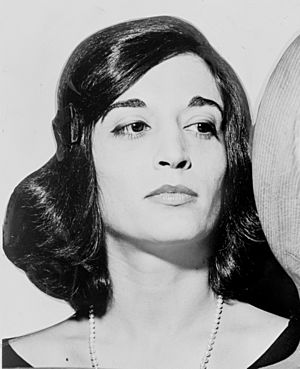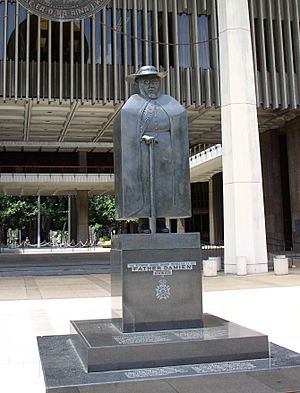Marisol Escobar facts for kids
Quick facts for kids
Marisol Escobar
|
|
|---|---|

Marisol Escobar (1963)
|
|
| Born |
Maria Sol Escobar
May 22, 1930 Paris, France
|
| Died | April 30, 2016 (aged 85) New York City, US
|
| Education | Jepson Art Institute École des Beaux-Arts Art Students League of New York Hans Hofmann School |
| Known for | Sculpture Assemblage |
|
Notable work
|
Women and Dog The Last Supper Dust Bowl Migrants Father Damien |
| Movement | Pop Art, New Realism |
| Awards | 1997 Premio Gabriela Mistral, from Organization of American States American Academy of Arts and Letters (1978) |
Marisol Escobar (May 22, 1930 – April 30, 2016), otherwise known simply as Marisol, was a Venezuelan-American sculptor born in Paris, who lived and worked in New York City. She became world-famous in the mid-1960s, but lapsed into relative obscurity within a decade. She continued to create her artworks and returned to the limelight in the early 21st century, capped by a 2014 major retrospective show organized by the Memphis Brooks Museum of Art.
Contents
Early life and education
Maria Sol Escobar was born on May 22, 1930, to Venezuelan parents in Paris, France. She was preceded by an elder brother, Gustavo. Her father, Gustavo Hernandez Escobar, and her mother, Josefina, were from wealthy families and lived off assets from oil and real estate investments. This wealth led them to travel frequently from Europe, the United States, and Venezuela. At some point in time, Maria Sol began going by Marisol, a common Spanish nickname.
Josefina Escobar died in 1941, when Marisol was eleven. Her death, followed by her father shipping Marisol off to boarding school in Long Island, New York, for one year, affected her very deeply. Marisol decided to not speak again after her mother's passing, although she made exceptions for answering questions in school or other requirements; she did not regularly speak out loud until her early twenties.
Although Marisol was deeply traumatized, this did not affect her artistic talents. She had begun drawing early in life, with her parents encouraging her talent by taking her to museums. Her talents in drawing frequently earned her artistic prizes at the various schools she attended before settling in Los Angeles in 1946. Marisol additionally displayed talent in embroidery, spending at least three years embroidering the corner of a tablecloth (including going to school on Sundays in order to work).
Marisol was very religious. During her teen years, she coped with the trauma of her mother's death by walking on her knees until they bled, keeping silent for long periods, and tying ropes tightly around her waist.
After Josefina's death and Marisol's exit from the Long Island boarding school, the family traveled between New York and Caracas, Venezuela. In 1946, when Marisol was 16, the family relocated permanently to Los Angeles; she was enrolled at the Marymount High School in Los Angeles. She disliked this institution, and transferred to the Westlake School for Girls in 1948.
Marisol Escobar began her formal arts education in 1946 with night classes at the Otis Art Institute and the Jepson Art Institute in Los Angeles, where she studied under Howard Warshaw and Rico Lebrun.
Marisol studied art at the Paris École des Beaux-Arts in 1949. She then returned to begin studies at the Art Students League of New York, at the New School for Social Research, and she was a student of artist Hans Hofmann.
Early career
The pop art culture in the 1960s embraced Marisol as one of its members, enhancing her recognition and popularity. She concentrated her work on three-dimensional portraits, using inspiration "found in photographs or gleaned from personal memories". Marisol took inspiration from found objects, such as a piece of wood that became her Mona Lisa sculpture, and an old couch that became The Visit.
She became a friend of Andy Warhol in the early 1960s; she made a sculptural portrait of him, and he invited her to appear in his early films The Kiss (1963) and 13 Most Beautiful Girls (1964).
Pop art
It was in the following decade of the 1960s that Marisol began to be influenced by pop artists such as Andy Warhol and Roy Lichtenstein. She appeared in two early films by Warhol, The Kiss (1963) and 13 Most Beautiful Girls (1964). One of her best-known works from this period is The Party, a life-size group installation of figures at the Toledo Museum of Art. All the figures, gathered together in various guises of the social elite, sport Marisol's face. Marisol dropped her family surname of Escobar in order to divest herself of a patrilineal identity and to "stand out from the crowd".
Her predisposition toward the forms of Pop Art stems, in part, from some of her earliest art training, dating back to her time under Howard Warshaw at the Jepson Art Institute. In an article exploring yearbook illustrations of a very young Marisol, author Albert Boimes notes the often uncited shared influence between her work and other Pop artists. He suggests a strong shared influence from both the Ashcan School and the form of Comics in general. He explains that "Marisol inherited some of the features of this tradition by way of her training under Howard Warshaw and Yasuo Kaiyoshi." Boimes also notes the profound effect that Comic book art had on the Pop Artists and Marisol herself, not to mention that the origins of the comic strip are deeply intertwined with the Ashcan School, explaining that, "The pioneers associated with the Ashcan School sprang from the same roots as pioneer cartoonists," and that, "almost all began their careers as cartoonists." He writes that comic strips and comic books, as well as animated cartoons, held a particular appeal for an entire generation of artists born around 1930, including Claes Oldenburg, Mel Ramos, Andy Warhol, Tom Wesselmann, James Rosenquist, and of course Roy Lichtenstein, the oldest of this group," all of whom were associated to one degree or another with Pop. Boime notes that "for a time Warshaw worked for Warner Bros. Animation drawing Bugs Bunny, and he later drew for The Walt Disney Company," and that there were "...numerous points of contact between Disney and the Jepson Art Institute..."
Marisol drifted through many artistic movements. "Not Pop, Not Op, It's Marisol!" was the way Grace Glueck titled her article in The New York Times in 1965: "Silence was an integral part of Marisol's work and life. She was said to have spoken no more than she needed to, and in her work she been described as having to bestowed silence with 'form and weight'. She talked little of her career and once stated, 'I have always been very fortunate. People like what I do.'"
In 1966-67, she completed Hugh Hefner, a sculptural portrait of the celebrity magazine publisher. She depicted him with two copies of his trademark smoking pipe, one painted, and the other a real one projecting aggressively from the front of the piece. The sculpture was featured on the March 3, 1967 cover of Time magazine. The work was acquired by Time, and is now in the collection of the National Portrait Gallery of the Smithsonian Institution. Curator Wendy Wick Reaves said that Escobar is "always using humor and wit to unsettle us, to take all of our expectations of what a sculptor should be and what a portrait should be and messing with them. So when she's asked why there are two pipes, she says, 'Well, Hugh Hefner has too much of everything.'"
Marisol's diversity, unique eye and character set her apart from any one school of thought. She has often included portraits of public figures, family members and friends in her sculpture. In one exhibit, "Marisol Escobar's The Kennedys criticized the larger-than-life image of the family" (Walsh, 8). In 1982-1984, her respect for Leonardo da Vinci led her to make a life-sized sculptural representation of herself contemplating her full-sized tableau of The Last Supper. She also did a work based on da Vinci's The Virgin with St. Anne.
Recognition and late career
Marisol's image is included in the iconic 1972 poster Some Living American Women Artists by Mary Beth Edelson.
Art critics, such as Lucy Lippard, began to recognize Marisol in terms of Pop art in 1965.
Marisol received awards including the 1997 Premio Gabriela Mistral from the Organization of American States for her contribution to Inter-American culture. She was elected to membership in the American Academy of Arts and Letters in 1978. Marisol created a series of wood sculptures in the 1990s, mostly depicting Native Americans. Two exhibits of these works were not well received, and, she felt, misunderstood. In 2004, Marisol's work was featured in "MoMA at El Museo", an exhibition of Latin American artists held at the Museum of Modern Art. Marisol's work has attracted increased interest, including a major retrospective in 2014 at the Memphis Brooks Museum of Art in Memphis, Tennessee, which also became her first solo show in New York City, at Museo del Barrio.
Last years
Escobar last lived in the TriBeCa district of New York City, and was in frail health towards the end of her life. She suffered from Alzheimer's disease, and died on April 30, 2016 in New York City from pneumonia, aged 85.
In April 2017, it was announced that Marisol's entire estate had been left to the Albright-Knox Art Gallery in Buffalo, New York.
In 2022, the Pérez Art Museum Miami presented Marisol and Warhol Take New York, commenting on the rising artistic careers of both Escobar and Andy Warhol. An accompanying catalogue was published by PAMM on the occasion of the exhibition.
Collections
Her work is included in the collections of the Pérez Art Museum Miami, Albright-Knox Art Gallery, The Metropolitan Museum of Art, the Currier Museum of Art, ICA Boston, and the Museum of Modern Art.
Awards
- 2016 Paez Medal of Art from VAEA (granted while alive, bestowed post mortem)
See also
 In Spanish: Marisol Escobar para niños
In Spanish: Marisol Escobar para niños


